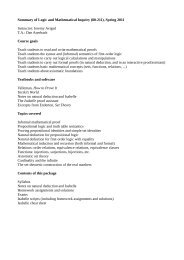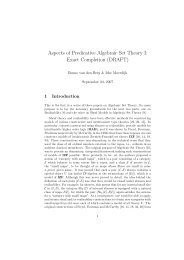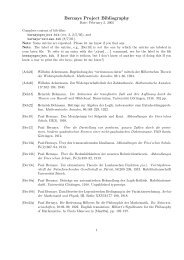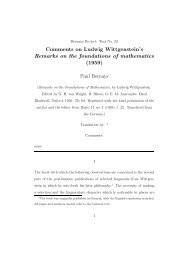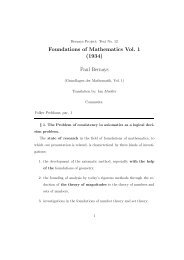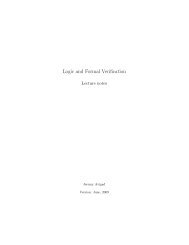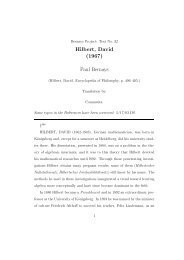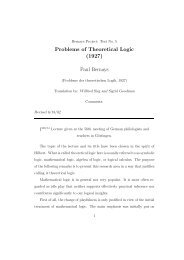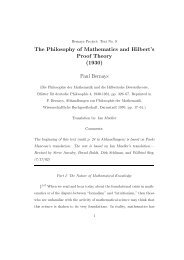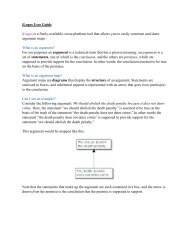Platonism in mathematics (1935) Paul Bernays - Phil Cmu
Platonism in mathematics (1935) Paul Bernays - Phil Cmu
Platonism in mathematics (1935) Paul Bernays - Phil Cmu
You also want an ePaper? Increase the reach of your titles
YUMPU automatically turns print PDFs into web optimized ePapers that Google loves.
<strong>in</strong> favor of <strong>in</strong>tuitionism.<br />
In addition, one must observe that the evidence which <strong>in</strong>tuitionism uses <strong>in</strong><br />
its arguments is not always of an immediate character. Abstract reflections<br />
are also <strong>in</strong>cluded. In fact, <strong>in</strong>tuitionists often use statements, conta<strong>in</strong><strong>in</strong>g a<br />
general hypothesis, of the form ‘if every number n has the property A(n),<br />
then B holds’.<br />
Such a statement is <strong>in</strong>terpreted <strong>in</strong>tuitionistically <strong>in</strong> the follow<strong>in</strong>g manner:<br />
‘If it is proved that every number n possesses the property A(n), then B.’<br />
Here we have a hypothesis of an abstract k<strong>in</strong>d, because s<strong>in</strong>ce the methods of<br />
demonstration are not fixed <strong>in</strong> <strong>in</strong>tuitionism, the condition that someth<strong>in</strong>g is<br />
proved is not <strong>in</strong>tuitively determ<strong>in</strong>ed.<br />
It is true that one can also <strong>in</strong>terpret the given statement by view<strong>in</strong>g it<br />
as a partial judgment, i.e., as the claim that there exists a proof of B from<br />
the given hypothesis, a proof which would be effectively given. 4 (This is<br />
approximately the sense of Kolmogorov’s <strong>in</strong>terpretation of <strong>in</strong>tuitionism.) In<br />
any case, the argument must start from the general hypothesis, which cannot<br />
be <strong>in</strong>tuitively fixed. It is therefore an abstract reflection.<br />
In the example just considered, the abstract part is rather limited. The<br />
abstract character becomes more pronounced if one superposes hypotheses;<br />
i.e., when one formulates propositions like the follow<strong>in</strong>g: ‘if from the hypoth-<br />
esis that A(n) is valid for every n, one can <strong>in</strong>fer B, then C holds’, or ‘If from<br />
the hypothesis that A leads to a contradiction, a contradiction follows, then<br />
B’, or briefly ‘If the absurdity of A is absurd, then B’. This abstractness of<br />
4 [“. . . c’est à dire comme une <strong>in</strong>dication d’un raisonnement conduisant de la dite hy-<br />
pothèse à la conclusion B, raisonnement qu’on présente effectivement.”]<br />
14



